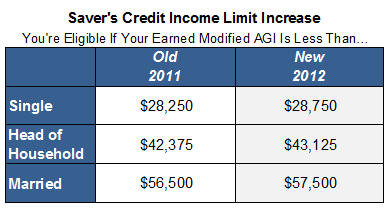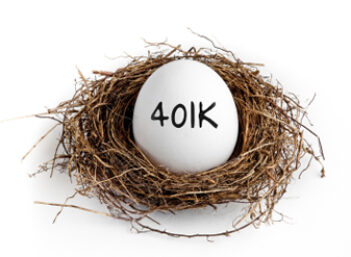In case you haven't noticed what your wallet has been trying to tell you, the cost of living has been rising lately.
According to the Bureau of Labor Statistics, the consumer price index (CPI) has risen 3.9% over the past 12 months. The price of energy (including gasoline) alone has increased by nearly 20%, and food prices have gone up 6% over the past year as well.
Fortunately, the rise in the cost of living has increased enough for the the IRS to take notice.
1. You May Contribute More To Your 401(k) Plan Or Other Employer-Sponsored Plan
- For the 2012 tax year, workers may contribute up to $17,000 ($500 more than in 2011) into their 401(k) plan, 403(b) plan, 457 plan or Thrift Savings Plan.
- If you're over age 50, you'll be able to contribute up to $22,500 into your employer-sponsored retirement plan (Note: The Catch-Up Contribution Limit of $5,500 remains unchanged for 2012).
Remember, every dollar you contribute into your 401(k) or other employer-sponsored plan (other than Roth plans) is tax-deductible. The more dollars you contribute, the smaller your tax bill will be.
It's a difficult feat for most, but if you could possibly manage to sock away $17,000 every year starting in 2012 (That's about $1,417 a month), you could grow your nest egg balance to $99,000 in 5 years, or $655,000 in 20 years -- assuming a 6% annual return.
[Have an old 401(k) sitting with a previous employer? Roll Over Your 401(k) Plan in 5 Easy Steps]
2. The IRA Income Limit Restrictions Have Been Loosened for 2012
While anyone can contribute to their own IRA, only workers who earn below a certain income level may receive a tax break (i.e. tax deduction) for each dollar they contribute. Next year, the income limit cap will be increased by $2,000, so people making more money will now be eligible for the tax-deductible contributions.
- If you earn a modified adjusted gross income (AGI) that is under $58,000 ($92,000 for married couples) for 2012, you'll be eligible to get a tax-deduction for every dollar you contribute (up to the existing annual contribution limit of $5,000 or $6,000 for those over age 50) into an IRA.
- The IRA tax-deduction phases out for those who earn a modified AGI between $58,000 and $68,000 ($92,000 to $112,000 for married couples).

- If you're a married couple that is filing jointly, but only one of you has an employer-sponsored plan, the IRS has increased the modified AGI limit for full tax-deduction eligibility to $173,000. This tax-deduction phases out for those who earn a modified AGI between $173,000 and $183,000. Note: These income limit caps have been increased by $4,000 over the 2011 tax year.
[InvestingAnswers Feature: The Pros and Cons of IRAs and 401(k)s]
3. Roth IRA Income Limit Restrictions Have Also Been Relaxed for 2012
The Roth IRA, a popular retirement account that offers tax-free withdrawals after age 59 ½, will see a slight change in eligibility rules as well. The IRS is raising the income caps on Roth IRAs, allowing higher income earners to contribute to the plan. The 2012 income cap will be $3,000 higher for single and head-of-household filers, and $4,000 higher for married couples filing jointly.
- For 2012, you'll be able to contribute to a Roth IRA if you earn a modified AGI below $110,000 ($173,000 for married couples).
- If you earn a modified AGI between $110,000 and $125,000 ($173,000 to $183,000 for married couples), you'll still be able to contribute to a Roth IRA; however, the amount you'll be able to contribute annually is more limited (i.e. phased out).

[InvestingAnswers Feature: Traditional Vs. Roth: Which IRA is Right for You?]
4. Eligibility for Saver's Credit Has Been Expanded
The income limit restrictions to be eligible for saver's credit have been loosened as well for 2012.
The income limit cap has been raised by $500 for single filers, $750 for head of household filers and $1,000 for married couples over 2011's limits.
Like the other income limit cap increases, this change will allow more workers with higher incomes to claim this popular tax credit.
The saver's credit -- also known as the retirement savings contributions credit -- rewards low income or moderate income workers who are contributing towards their retirement plan.
If you're eligible for the saver's credit, you can receive a tax credit up to $1,000 ($2,000 for joint filers) depending on the amount you contribute towards a 401(k) plan, IRA, Roth IRA or other retirement plan.
- You may claim the saver's credit if you contribute toward a retirement account and your modified AGI is below $28,750 (or $57,500 for married couples) for the 2012 tax year.
- The modified AGI limit for head of household filers is now $45,125; so if you qualify as head of household and make below that amount, you too may claim this rewarding tax credit.

The Investing Answer: Keep these income limits and contribution limits in mind when tax planning next year. Whether you'll be eligible after these changes or if you've always been eligible to contribute to an IRA, Roth IRA or 401(k) plan, be sure and take advantage of these tax-sheltered plans if you have the means to do so.
If you're worker who makes a low or moderate income, the saver's credit could be looked at as free money on the table. Similar to a company's 401(k) match, this credit rewards you for every dollar you put into a 401(k) plan, Roth IRA or IRA. If you earn less than the income limit shown earlier, and you can put $2,000 towards retirement, you could potentially receive up to a $1,000 tax credit (depending on your actual level of income); Take advantage of this credit if you can.
[Start investing in your own Roth IRA or IRA today using our guide: The Lazy Man's Retirement Portfolio]



